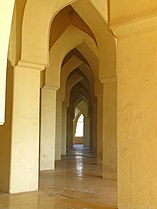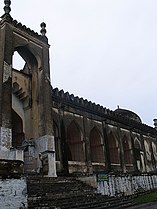Jama Mosque Kalaburagi
| Jamia Masjid Gulbarga | |
|---|---|
 Jamia Masjid Gulbarga | |
| Religion | |
| Affiliation | Islam |
| Ecclesiastical or organizational status | Mosque |
| Location | |
| Location | Gulbarga, Karnataka, India |
| Geographic coordinates | 17°21′37″N 78°28′24″E / 17.360305°N 78.473416°E |
| Architecture | |
| Type | Islamic architecture |
| Style | Bahmani Sultanate |
| Completed | 1367 AD |
| Specifications | |
| Capacity | 2000 |
| Length | 216 ft (66 m) |
| Width | 177 ft (54 m) |
| Minaret(s) | - |
| Materials | Lime Brick |
Jamia Masjid Gulbarga or Friday Mosque of Gulbarga is a mosque located in Gulbarga, Karnataka, India.[1]
The mosque was built in 1367 by Bahmani Sultan Mohammed Shah I to commemorate the establishment of the capital in Gulbarga following the defeat Kapaya Nayaka of Warangal. The mosque was designed by a Persian architect, Rafi, and built within the broader Gulbarga Fort complex.[2] It is one of the earliest Friday mosques in South India.[3]
The complex was put by UNESCO on its "tentative list" to become a World Heritage Site in 2014, with others in the region, under the name Monuments and Forts of the Deccan Sultanate (despite there being a number of different sultanates).[4]
Architecture[edit]
The Gulbarga Friday Mosque is notable for its divergence from typical mosque architecture of the time.[3] The basic layout is similar to that of a courtyard mosque, except that the central courtyard is covered by sixty-three small domes. The mosque also lacks minarets, instead having four larger domes at each corner of the mosque. Three of the four outer walls are also open to sunlight, while the qibla is solid.
The mosque is also recognized for its influences from Moorish architecture, sharing some design characteristics with the Mosque–Cathedral of Córdoba.
Gallery[edit]
-
Arches Inside the Jama Mosque.
-
Arches Inside the Jama Mosque.
-
Arches inside the mosque.
-
Another view of arches inside the mosque.
-
Entrance of the mosque, constructed in Moorish style.
-
View of the mosque, in monsoon, covered with seasonal grass.
See also[edit]
References[edit]
- ^ Haig, Major Thomas Wolseley (1907). Historic Landmarks Of The Deccan. pp. 85-86.
- ^ "Jama Masjid, Gulbarga". Archived from the original on 18 April 2024. Retrieved 18 April 2024.
- ^ a b "Archnet". Archived from the original on 20 November 2010. Retrieved 28 April 2017.
- ^ UNESCO "tentative list"
External links[edit]






